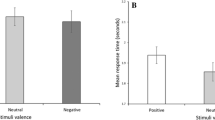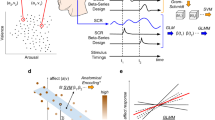Abstract
Skin resistance, corrugator muscle tension, and self-report were used to assess the effect of visually and verbally processing depressive, neutral, and pleasant scenes in 10 dysphoric and 10 nondysphoric college students. The dysphoric students scored above 10 on the Beck Depression Inventory (BDI). Data were analyzed in a 2 ×2 ×3 (dysphoria group ×type of processing ×scene affect) analysis of variance design. Verbal processing increased autonomic and skeletal arousal more than did visual imaging. Verbal processing was rated more depressing than, and generated more related, visual imaging. Depressive stimuli were rated more vivid and stronger when verbally processed, whereas neutral and pleasant stimuli were rated more vivid when visually imaged. Dysphoric subjects showed low resting autonomic arousal, and less muscular but more autonomic arousal to stimulation than nondysphoric subjects. The BDI correlated .75 with the Taylor Manifest Anxiety Scale (hence “dysphoria”). The relationship of these findings to current issues in psychopathology, assessment, cognitive-behavior therapy, and cognitive theory was discussed.
Similar content being viewed by others
Reference Notes
Shaw, B. F.Subjective and physiological responses to depression inducing stimuli. Master's thesis, University of Western Ontario, 1972.
McGuire, A.Variables affecting subjective and physiological responses to emotion-inducing stimuli. Master's thesis, University of Western Ontario, London, 1974.
References
Anderson, J. R. Arguments concerning representations for mental imagery.Psychological Review 1978,85 249–277.
Beck, A. T.Depression: Clinical, experimental and therapeutic aspects. New York: Harper & Row, 1967.
Beck, A. T. Role of fantasies in psychotherapy and psychopathology.Journal of Nervous and Mental Disease 1970,150 3–17.
Beck, A. T. Cognition, affect, and psychopathology.Archives of General Psychiatry 1971,24 495–500.
Beck, A. T. The development of depression: A cognitive model. In R. J. Friedman & M. M. Katz (Eds.),The psychology of depression: Contemporary theory and research. New York: Wiley, 1974.
Beck, A. T., Ward, C. H., Mendelson, M., Mock, J., & Erbaugh, J. Inventory for measuring depression.Archives of General Psychiatry 1961,4 561–571.
Benson, H.The relaxation response. New York: Avon, 1975.
Betts, G. H.The distribution and functions of mental imagery. New York: Teachers College, Columbia University, 1909.
Bower, G. H. Contacts of cognitive psychology with social learning theory.Cognitive Therapy and Research 1978,2 123–146.
Cautela, J. R. Covert sensitization.Psychological Report 1967,20 459–468.
Cautela, J. R. Covert extinction.Behavior Therapy 1971,2 192–200.
Chowdhury, K. R., & Vernon, P. E. An experimental study of imagery and its relation to abilities and interests.British Journal of Psychology 1964,55 355–364.
Ellis, A.Reason and emotion in psychotherapy, New York: Lyle Stuart, 1962.
Ellis, A. Rational psychotherapy. In H. J. Eysenck (Ed.),Experiments in behavior therapy. New York: Macmillan, 1964.
Galton, F.Inquiries into human faculty and its development. London: Macmillan, 1883, 1907.
Goldstein, I. G. The relationship of muscle tension and autonomic activity to psychiatric disorders.Psychosomatic Medicine 1965,27 39–52.
Greenfield, N. S., Kate, D., Alexander, A. A., & Roessler, R. The relationship between physiological and psychological responsivity: Depression and galvanic skin response.Journal of Nervous and Mental Disease 1963,136 535–539.
Grossberg, J., & Wilson, H. Physiological changes accompanying the visualization of fearful and neutral situations.Journal of Personality and Social Psychology 1968,10 124–133.
Hammen, C. L., & Krantz, S. Effect of success and failure on depressive cognitions.Journal of Abnormal Psychology 1976,85 577–586.
Hiscock, M. Imagery assessment through self-report: What do imagery questionnaires measure?Journal of Consulting and Clinical Psychology 1978,46 223–230.
Hogan, R. A., & Kirchner, J. H. A preliminary report of the extinction of learned fears via a short-term implosive therapy.Journal of Abnormal Psychology 1967,72 106–109.
Jacobson, E. Electrophysiology of mental activities and introduction to the psychological process of thinking. In F. J. McGuigan & R. A. Schoonover (Eds.),The psychophysiology of thinking: Studies of covert processes. London: Academic Press, 1973.
Kazdin, A. E. Covert modeling, imagery assessment, and assertive behaviors.Journal of Consulting and Clinical Psychology. 1975,43 716–724.
Kolvin, I. “Aversive imagery” treatment in adolescents.Behaviour Research and Therapy 1967,5 245–249.
Lader, M. H. The psychophysiology of anxious and depressed patients. In D. C. Fowles (Ed.),Clinical applications of psychophysiology. New York: Columbia University Press, 1975.
Lader, M. H., & Wing, L. Physiological measures in agitated and retarded depressed patients.Journal of Psychiatric Research 1969,7 89–100.
Lang, P. J. Imagery in therapy: An information processing analysis of fear.Behavior Therapy 1977,8 862–886.
Lewinsohn, P. M., Lobitz, W. C., & Wilson, S. “Sensitivity” of depressed individuals to aversive stimuli.Journal of Abnormal Psychology 1973,81 259–263.
Lindauer, M. S. Imagery and sensory modality.Perceptual and Motor Skills 1969,29 203–215.
Lykken, D. T. The role of individual differences in psychophysiological research. In P. H. Venables & M. J. Christie (Eds.),Research in psychophysiology. London: Wiley, 1975.
Mahoney, M. J., & Thoresen, C. E.Self control: Power to the person. Monterey, California: Brooks/Cole, 1974.
Marks, I. M., & Gelder, M. G. Transvestism and fetishism: Clinical and psychological changes during faradic aversion.British Journal of Psychiatry 1967,113 711–739.
Martin, I., & Davies, B. M. The effect of Na amytal in autonomic and muscle activity of patients with depressive illness.British Journal of Psychiatry 1965,111 168–175.
May, J. R. A psychophysiological study of self and externally regulated phobic thoughts.Behavior Therapy 1977,8 849–861. (a)
May, J. R. Psychophysiology of self regulated phobic thoughts.Behavior Therapy 1977,8 150–159. (a)
May, J., & Johnson, H. Physiological activity to internally elicited arousal and inhibitory thoughts.Journal of Abnormal Psychology 1973,82 239–245.
Meichenbaum, D. Self-instructional methods. In F. H. Kanfer & A. P. Goldstein (Eds.),Helping people change. New York: Pergamon Press, 1975.
Meichenbaum, D.Cognitive-behavior modification. New York: Plenum, 1977.
Meyers, J. L.Fundamentals of experimental design (2nd ed.). Boston: Allyn & Bacon, 1972.
Nebes, R. D. Hemispheric specialization in commissurotomized man.Psychological Bulletin 1974,81 1–14.
Osgoode, C. E., Suci, G. J., & Tannenbaum, P. H.The measurement of meaning. Urbana: University of Illinois Press, 1957.
Paivio, A.Imagery and verbal processes. New York: Holt, Rinehart & Winston, 1971.
Paivio, A. Psychophysiological correlates of imagery. In F. J. McGuigan & R. A. Schoonover (Eds.),The Psychophysiology of thinking: Studies of covert processes. London: Academic Press, 1973.
Paivio, A. Images, propositions and knowledge. In J. M. Nicholas (Ed.),Images, perception, and knowledge (The Western Ontario Series in the Philosophy of Science). Dordrecht, The Netherlands: Reidel, 1976.
Pylyshyn, Z. W. What the mind's eye tells the mind's brain: A critique of mental imagery.Psychological Bulletin 1973,80 1–24.
Rechtschaffen, A. The psychophysiology of mental actvity during sleep. In F. J. McGuigan & R. A. Schoonover (Eds.),The Psychophysiology of thinking: Studies of covert processes. London: Academic Press, 1973.
Richardson, A. Verbalizer-visualizer: A cognitive style dimension.Journal of Mental Imagery 1977,1 109–126.
Rimm, D. C., & Litvak, S. B. Self-verbalization and emotional arousal.Journal of Abnormal Psychology 1969,74 181–187.
Schwartz, G. E. Biofeedback, self-regulation, and the patterning of physiological processes.American Scientist 1975,63 314–324.
Sheehan, P. W. A shortened form of Betts' Questionnaire Upon Mental Imagery.Journal of Clinical Psychology 1967,23 386–389.
Stampfl, T. G., & Levis, D. J. Essential of implosive therapy: A learning-theory-based psychodynamic behavioral therapy.Journal of Abnormal Psychology 1967,72 496–503.
Suarez, Y., Crowe, M. J., & Adams, H. E. Depression: Avoidance learning and physiological correlates in clinical and analog populations.Behaviour Research and Therapy 1978,16 21–31.
Taylor, J. A. A personality scale of manifest anxiety.Journal of Abnormal and Social Psychology 1953,48 285–290.
Thurrell, R. J., Greenfield, N. S., & Roessler, R. The prediction of physiological responsivity from psychological responsivity.Journal of Psychosomatic Research 1961,5 211–214.
Venables, P. H., & Martin, I. Skin resistance and skin potential. In P. H. Venables & I. Martin (Eds.),A manual of psychophysiological methods. London: North-Holland, 1967.
Waters, W., & McDonald, D. Autonomic response to auditory, visual, and imagined stimuli in a SD context.Behaviour Research and Therapy 1973,11 577–585.
White, K. D., Ashton, R., & Brown, R. M. D. The measurement of imagery vividness: Normative data and their relationship to sex, age and modality differences.British Journal of Psychology 1977,68 203–211.
White, K. D., Ashton, R., & Law, H. The measurement of imagery vividness: Effects of format and order on the Betts' Questionnaire Upon Mental Imagery.Canadian Journal of Behavioural Science 1978,10 68–78.
Wiggins, J. S.Personality and prediction: Principles of personality assessment. London: Addison-Wesley, 1973.
Wolpe, J.Psychotherapy by reciprocal inhibition. Stanford: Stanford University Press, 1958.
Wolpe, J., & Lazarus, A. A.Behavior therapy techniques. New York: Pergamon Press, 1966.
Yates, A. J.Theory and practice in behavior therapy. New York: Wiley, 1975.
Zuckerman, M., Persky, H., & Curtis, G. C. Relationship among anxiety, depression, hostility and autonomic variables.Journal of Nervous and Mental Disease 1968,146 481–487.
Author information
Authors and Affiliations
Rights and permissions
About this article
Cite this article
Baker, L.L., Jessup, B.A. The psychophysiology of affective verbal and visual information processing in dysphoria. Cogn Ther Res 4, 135–148 (1980). https://doi.org/10.1007/BF01173645
Issue Date:
DOI: https://doi.org/10.1007/BF01173645




